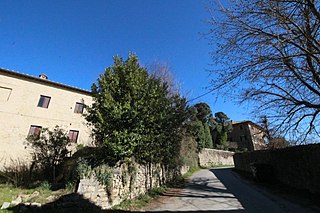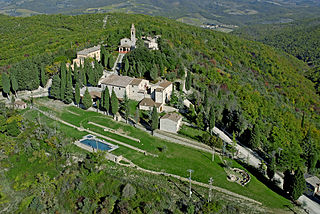
A Chianti wine is any wine produced in the Chianti region of central Tuscany. It was historically associated with a squat bottle enclosed in a straw basket, called a fiasco. However, the fiasco is only used by a few makers of the wine as most Chianti is now bottled in more standard shaped wine bottles. In the mid-late 19th century, Baron Bettino Ricasoli helped establish Sangiovese as the blend's dominant variety, creating the blueprint for today's Chianti wines.

The province of Siena is a province in Tuscany, Italy. Its capital is the city of Siena.

Monteriggioni is a comune in the province of Siena in the Italian region of Tuscany. It borders on the communes of Casole d'Elsa, Castellina in Chianti, Castelnuovo Berardenga, Colle di Val d'Elsa, Poggibonsi, Siena and Sovicille. The town is architecturally and culturally significant; it hosts several piazzas, and is referenced in Dante Alighieri's Divine Comedy.

Castellina in Chianti is a comune (municipality) of c. 2,800 inhabitants in the province of Siena, in the Italian region Tuscany, located about 35 kilometres (22 mi) south of Florence and about 15 kilometres (9 mi) northwest of Siena. It is part of the Chianti Hills, between the valleys of the Arbia, Pesa and Elsa rivers.

Castelnuovo Berardenga is a comune (municipality) in the province of Siena in the Italian region Tuscany, located about 50 kilometres (31 mi) southeast of Florence and about 14 kilometres (9 mi) east of Siena. Since 1932 it is included in the Chianti wine-production area.

Radda in Chianti is a comune (municipality) in the Province of Siena in the Italian region Tuscany, located about 35 kilometres southeast of Florence and about 15 km north of Siena.

Tuscan wine is Italian wine from the Tuscany region. Located in central Italy along the Tyrrhenian coast, Tuscany is home to some of the world's most notable wine regions. Chianti, Brunello di Montalcino and Vino Nobile di Montepulciano are primarily made with Sangiovese grape whereas the Vernaccia grape is the basis of the white Vernaccia di San Gimignano. Tuscany is also known for the dessert wine Vin Santo, made from a variety of the region's grapes. Tuscany has forty-one Denominazioni di origine controllata (DOC) and eleven Denominazioni di Origine Controllata e Garantita (DOCG). In the 1970s a new class of wines known in the trade as "Super Tuscans" emerged. These wines were made outside DOC/DOCG regulations but were considered of high quality and commanded high prices. Many of these wines became cult wines. In the reformation of the Italian classification system many of the original Super Tuscans now qualify as DOC or DOCG wines but some producers still prefer the declassified rankings or to use the Indicazione Geografica Tipica (IGT) classification of Toscana. Tuscany has six sub-categories of IGT wines today.

The Arbia is a torrent in Tuscany, central Italy, a tributary of the river Ombrone. Its source is located in the comune of Castellina in Chianti, at 620 m above sea level. It flows into the Ombrone near Buonconvento.

The history of Chianti dates back to at least the 13th century with the earliest incarnations of Chianti as a white wine. Today this Tuscan wine is one of Italy's most well known and recognizable wines. In the Middle Ages, the villages of Gaiole, Castellina and Radda located near Florence formed as a Lega del Chianti creating an area that would become the spiritual and historical "heart" of the Chianti region and today is located within the Chianti Classico Denominazione di Origine Controllata e Garantita (DOCG). As the wines of Chianti grew in popularity other villages in Tuscany wanted their lands to be called Chianti. The boundaries of the region have seen many expansions and sub-divisions over the centuries. The variable terroir of these different macroclimates contributed to diverging range of quality on the market and by the late 20th century consumer perception of Chianti was often associated with basic mass-market Chianti sold in a squat bottle enclosed in a straw basket, called fiasco.

Chianti, in Italy also referred to as Monti del Chianti or Colline del Chianti, is a mountainous area of Tuscany in the provinces of Florence, Siena and Arezzo, composed mainly of hills and mountains. It is known for the wine produced in and named for the region, Chianti.
Bianciardi is an Italian family name.
In the Middle Ages and Renaissance was in particular an important Florentine noble family that maintained strong ties with the Catholic Church.
Several people have left several traces of their lives to date, particularly bankers, knights, landlords and scholars who have had relationships with other well-known personalities, including members of the Visconti, Villani, Aldighieri and Medici families.
In Old Italian, in the late 17th and early 20th centuries, it assumed the synonym of "whitish" as gallicism of the French word Blanchard, as confirmed by the linguist Salvioni.
An example of literary text where it's used as word is in the D'Annunzio's work Le faville del maglio.

Castellina Scalo is a town in Tuscany, central Italy, administratively a frazione of the comune of Monteriggioni, province of Siena. At the time of the 2001 census its population was 1,809.

Fonterutoli is a village in Tuscany, central Italy, administratively a frazione of the comune of Castellina in Chianti, province of Siena. At the time of the 2001 census its population was 80.

La Piazza is a village in Tuscany, central Italy, administratively a frazione of the comune of Castellina in Chianti, province of Siena. At the time of the 2001 census its population was 36.

Lilliano is a village in Tuscany, central Italy, administratively a frazione of the comune of Castellina in Chianti, province of Siena. At the time of the 2001 census its population was 15.

San Leonino is a village in Tuscany, central Italy, administratively a frazione of the comune of Castellina in Chianti, province of Siena. At the time of the 2001 census its population was 11.

Pietrafitta is a village in Tuscany, central Italy, administratively a frazione of the comune of Castellina in Chianti, province of Siena. At the time of the 2018 parish census its population was 83.

Sant'Agnese is a village in Tuscany, central Italy, administratively a frazione of the comune of Castellina in Chianti, province of Siena. At the time of the 2018 parish census its population was 90.

Sicelle is a village in Tuscany, central Italy, located in the comune of Castellina in Chianti, province of Siena.
Sant'Agnese may refer to:


















